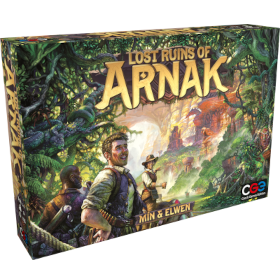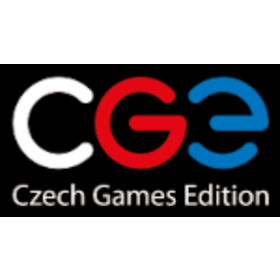Ztracený ostrov Arnak
 Na neobydleném ostrově v neprobádaných mořích našli průzkumníci stopy velké civilizace. Nyní povedete výpravu za prozkoumáním ostrova, hledáním ztracených artefaktů a tváří v tvář děsivým strážcům, to vše ve snaze dozvědět se tajemství ostrova.
Na neobydleném ostrově v neprobádaných mořích našli průzkumníci stopy velké civilizace. Nyní povedete výpravu za prozkoumáním ostrova, hledáním ztracených artefaktů a tváří v tvář děsivým strážcům, to vše ve snaze dozvědět se tajemství ostrova.
Ztracený ostrov Arnak neotřelým způsobem kombinuje mechaniky deck-buildingu, worker placementu a resource managementu. Kromě tradičních deck-buildingových efektů lze karty také použít k umístění nových workerů a nové akce budou dostupné, když hráči prozkoumají ostrov. Některé z těchto akcí vyžadují zdroje namísto workerů, takže vybudování pevné zdrojové základny je zásadní. Jste omezeni pouze na jednu akci v tahu, takže si pečlivě vybírejte...která akce vám právě teď přinese nejvíc benefitů? A co si můžete dovolit udělat později...za předpokladu, že někdo jiný neprovede tuto akci jako první?!
Balíčky jsou malé a náhodnost ve hře je silně zmírněna množstvím taktických rozhodnutí nabízených na herním plánu. Díky různým akcím pracovníků, artefaktům a kartám vybavení bude nastavení pro každou hru jedinečné a povzbudí hráče, aby prozkoumali nové strategie, jak čelit výzvě.
Počet hráčů: 2 - 4
Trvání hry: 28 mn
Složitost: 3 / 5
Hraj Ztracený ostrov Arnak a 1194 dalších her online.
Žádné stahování, hraj přímo ve webovém prohlížeči.
S tvými přáteli a tisíci hráči z celého světa.
Zdarma.

Hraj Ztracený ostrov Arnak a 1194 dalších her online.
Žádné stahování, hraj přímo ve webovém prohlížeči.
S tvými přáteli a tisíci hráči z celého světa.
Zdarma.

Přehled pravidel
The lists in these rules are displayed incorrectly when viewed on a BGA game page.
To read a correctly formatted version, you must open the wiki rules page in a new tab. (If you want to help fix these rules, see this guide for advice.)Theme
In Lost Ruins of Arnak, you'll be trying to uncover the titular lost ruins and the area around it. You'll do this by sending out your team of archaeologists to various locations to gather resources, collect cards for various effects, and advance on a research track to further find the lost ruins. The player with the most points at the end wins the game!
Components and Resources
In Lost Ruins of Arnak, each player has their own board, mostly to track their own resources and pieces. To gain resources a player can use their explorers, cards, idols, or guardians, as well as any resources they've acquired.
Player Components
- Two explorers, which can be placed on the main board to activate revealed locations or investigate new spaces.
- Cards, which can be used for various effects. Each player has a hand of cards they can play, a draw pile that can be drawn from, and a discard pile for previously used cards.
- Idols, earned as a reward for being the first to explore new locations, and can be spent for a few bonus effects. Each idol is also worth 3 points, and bonus effects that were never invoked also award points.
- Defeated guardians, which can be overcome from the main board. Each guardian is worth 5 points.
Resources
- Coins, used to buy more item cards and sometimes used to advance on the research track.
- Compasses, used to explore new locations and buy artifact cards.
- Tablets, used to activate artifact cards or advance on the research track.
- Arrowheads, used to advance on the research track.
- Jewels, used to advance on the research track.
Game Board
In game setup, players can choose between the Bird Temple, or a more complex Snake Temple. Each has its own temple and research tracks. On the game board there are:
- On the top: a market with cards for purchase, with artifacts costing compasses on the left and items costing coins on the right This also serves as a round tracker that advances to the right each round, increasing the ratio of artifacts to items.
- The map, which contains various actions that explorers can activate by visiting, ranging from advanced at the top to basic at the bottom.
- The research track, where players can advance their tokens (magnifying glass and book) by spending certain resources, thus gaining the rewards on the right side and possibly tokens from that space as well.
Structure Of A Round
Lost Ruins of Arnak takes place across five rounds. Each round essentially lasts until all other players have passed, then end of round/ start of round effects happen before the next round starts.
Round Phases:
- Start: At the beginning of each round, each player draws cards from their deck to fill their hand up to 5 cards.
- Turns: starting with the player with the clock token and proceeding around the table, each player takes a turn until all players have passed. Possible actions during a turn are described later.
- Cleanup: Once all players have passed, all players do the following:
- Return Explorers: For each explorer that ended their turn on a space with a guardian, the owner adds a Fear card to their discard pile. Then they collect all explorers on the board back to their supply.
- Discard and Cycle Cards: If any cards remain in a player's hand, they may discard any of them. Then all players shuffle their discard piles and place them underneath their draw piles (so that any cards not drawn last round will be drawn again first).
- Refresh Assistants: Make all of your assistants right side up so that they may be used again.
- Pass Token: The first player token passes one player to the left.
- Refresh Shop: The artifact and item card closest to the round marker are both exiled. The round marker advances one space to the right, then both card markets are refilled.
Actions on your turn
During each turn, a player takes one main action, which can be preceded or followed by any number of optional free actions.
Main actions:
- Play a card from your hand (unless it has a lightning bolt symbol, in which case it's a free action). Do what the card says, then discard it. If the card is an artifact, you need to pay one tablet first to activate its effect.
- Use an assistant (unless it has a lightning bolt symbol, in which case it's a free action). Follow the instructions on the assistant and turn it sideways to indicate that it was used this round.
- Buy a card from the market. The cost for any given card is in the bottom left corner. If it's an item, put the card at the bottom of your deck. If it's an artifact, immediately use its effect as if you played it, then put it in your discard pile. Either way, refill the market by moving all cards of that type towards the round tracker, then add a new card from its deck.
- Send an explorer to a location by paying its travel cost (circular icon(s) at the location depicting vehicles). If it is an undiscovered location, you will need to pay its compass cost as well (green compass icons below the location level area, if any) [see below]. You will gain the resource or bonus pictured on the space. In addition, if it was an undiscovered level 1 or 2 location, you will gain an idol (2 for a level 2), reveal and apply the location's action and then reveal a guardian as well.
- Sending an explorer - Travel Cost: Typically this is paid by discarding a card or cards from your hand with the required symbol(s) or higher ranked symbol(s), but there are other effects that accomplish this.
- Travel Icon Hierarchy:
- Boot symbol can be paid with any travel symbol
- Boat symbol can be paid with a boat or plane symbol
- Car symbol can be paid with a car or plane symbol
- Plane symbol can only be paid with a plane symbol
- Travel Icon Hierarchy:
- Sending an explorer - Compass costs (undiscovered locations only):
- Level 0 locations (bottom of the board) do not cost compasses
- Level 1 locations cost 3 compasses
- Level 2 locations cost 6 compasses
- Sending an explorer - Travel Cost: Typically this is paid by discarding a card or cards from your hand with the required symbol(s) or higher ranked symbol(s), but there are other effects that accomplish this.
- Overcome a guardian, if you have an explorer on a space that contains one. Pay the resources and symbols on the guardian to claim it. This will be worth 5 points at the end of the game, prevents you from gaining Fear cards, and gives you another bonus that can be used once per game as a free action or travel symbol.
- Advance on the research track by paying the cost between the spaces. If you're the first player to reach a space, remove the bonus token on the space and remove it. Either way, you'll also get the bonus listed on the right side of the track. You can move either the notebook or magnifying glass, but the notebook can never advance further than the magnifying glass.
- Gain a temple tile if your magnifying glass is at the top of the research track. You may pay a combination of symbols listed below the tiles - the more you pay, the better tile you will get. You'll gain a brown tile worth 2 points for one set of symbols, a silver symbol worth 6 symbols for two, or a gold tile worth 11 points for all three.
- Pass. This means that you will take no more turns for the round. Generally you will want to use all of your cards before you do this.
Free Actions:
- Play a free action card from your hand. Many of these give you resources.
- Use a free action assistant. Many of these give you resources.
- Spend an idol for a bonus effect, choosing one of the five bonus options pictured to the left of the idols. Keep in mind each uncovered space gives points at game end.
- Use the effect of an overcome guardian. Each guardian's effect can be used only once per game.
End of the Game
The game ends after five rounds. When the game ends, you'll score points, which will come from:
- The cards in your deck. Lose 1 point for each Fear card, but gain points for all other cards as indicated by their point values in the bottom right corner. (All other starting cards are not worth any points.)
- Idols. Each idol is worth 3 points, whether it was spent or not. In addition, score points for each unused idol bonus slot.
- Guardians. Each guardian you overcame is worth 5 points, whether you used its bonus effect or not.
- Research track positions. Gain points for the position of your magnifying glass and notebook, as noted on the right side of the research track.
- Temple Tiles gained in the lost ruins. Each bronze tile is worth 2 points, silver is worth 6, and gold is worth 11.
The player with the most points wins! Ties are broken with preference towards the player who reached the top of the research track first, or was closest to doing so.

